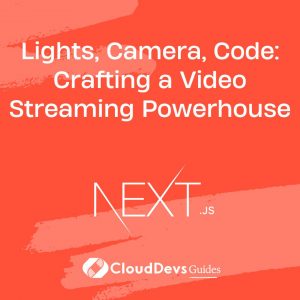Lights, Camera, Code: Crafting a Video Streaming Powerhouse
In the fast-paced world of tech startups, video streaming platforms have become an essential tool for engaging audiences and delivering content. Whether you’re creating an e-learning platform, a live streaming service, or simply want to host video content, choosing the right technology stack is crucial. In this article, we’ll explore how to build a robust video streaming platform using NEXT.js and Video.js, two powerful tools that can help you deliver seamless video experiences to your users.

Table of Contents
1. Why NEXT.js and Video.js?
Before diving into the technical details, let’s briefly discuss why NEXT.js and Video.js are excellent choices for building your video streaming platform.
– NEXT.js: NEXT.js is a popular React framework that offers server-side rendering (SSR), static site generation (SSG), and a great developer experience. It provides excellent SEO capabilities and allows for efficient rendering of web pages, making it an ideal choice for building dynamic web applications like video streaming platforms.
– Video.js: Video.js is a flexible and customizable open-source HTML5 video player that works seamlessly across various platforms and devices. It offers a wide range of features, including adaptive streaming, video analytics, and plugin support, making it a powerful tool for creating a feature-rich video player for your platform.
Now, let’s get into the steps of building your video streaming platform.
Step 1: Setting Up Your NEXT.js Project
- Initialize Your Project: Start by creating a new NEXT.js project using the following command:
``` npx create-next-app video-streaming-platform ```
- Install Dependencies: Install the necessary dependencies, including Video.js and any additional packages you may need. You can use npm or yarn for this:
``` npm install video.js ```
- Create Pages: Define the pages for your video streaming platform, such as the homepage, video playback page, and user dashboard. NEXT.js makes it easy to create these pages and manage routing.
- Design Your UI: Use React components to design your platform’s user interface. Consider using popular UI frameworks like Material-UI or Tailwind CSS to streamline the process.
Step 2: Integrating Video.js
- Import Video.js: Import Video.js into your project and create a video player component that utilizes Video.js. You can customize the player’s appearance and behavior to match your platform’s design.
- Loading Videos: Implement a mechanism to load videos into your platform. You can host videos on your server or use external video hosting services like Vimeo or YouTube. Video.js supports various video sources and formats, making it versatile for different scenarios.
- Video Playback Controls: Customize the playback controls, including play, pause, volume, and fullscreen options. You can also add additional features like subtitles, quality settings, and playback speed controls.
Step 3: Building Advanced Features
- User Authentication: Implement user authentication to ensure that only authorized users can access premium content or contribute to your platform. You can use libraries like Firebase Authentication or Auth0 for this purpose.
- Content Management: Create a backend system for managing video content, including uploading, categorizing, and organizing videos. Utilize a database such as Firebase Firestore or MongoDB to store metadata and user interactions.
- Analytics and Insights: Integrate video analytics tools to track user engagement, video views, and user behavior. Services like Google Analytics or Mixpanel can provide valuable insights to improve your platform’s performance.
- Monetization: Explore various monetization strategies, such as subscription models, pay-per-view, or advertising. Integrate payment gateways like Stripe or PayPal to enable secure transactions.
Step 4: Testing and Optimization
- Testing: Thoroughly test your video streaming platform across different browsers and devices to ensure compatibility. Test video playback, responsiveness, and user interactions.
- Performance Optimization: Optimize your platform for speed and performance by implementing lazy loading for videos, using CDNs (Content Delivery Networks), and minimizing unnecessary resource requests.
- SEO: Implement SEO best practices to improve your platform’s discoverability. NEXT.js provides built-in support for SEO optimization.
Step 5: Launch and Scale
Once you’ve completed the development and testing phases, it’s time to launch your video streaming platform. Promote your platform to your target audience and gather user feedback to make continuous improvements.
Conclusion
Building a video streaming platform with NEXT.js and Video.js offers a solid foundation for delivering high-quality video content to your audience. By following these steps and continuously iterating on your platform, you can create a compelling and engaging experience for your users.
Further Reading:
- NEXT.js Documentation – https://nextjs.org/docs/getting-started/introduction
- Video.js Documentation – https://docs.videojs.com/
- Firebase Authentication – https://firebase.google.com/docs/auth
Table of Contents






